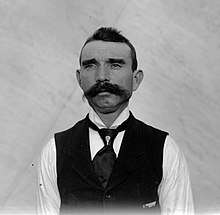Ivy Baldwin
Ivy Baldwin (born William Ivy July 31, 1866 – October 8, 1953, in Houston, Texas, he changed his name in later years to Ivy Baldwin so that he and his partner, Thomas Scott Baldwin, could be billed as "The Baldwin Brothers". [1] Ivy Baldwin was an American balloonist, aeronaut and high-wire performer. He is credited with being the first aviator to be shot down during wartime in the U.S.[2] during the Spanish–American War.[3]

Biography
In 1877 he performed in Thayer Dollar Circus as a tightrope walker. He later joined with Thomas and Sam Baldwin—billed as "The Baldwin Brothers"—performing high wire acts as well as balloon ascensions and parachuting. The Baldwin Brothers performed using handmade balloons filled with hot air which would ascend to 2500 feet as Ivy Baldwin performed acrobatics and would parachute to the ground.[4] He became a solo performer in 1893 and joined the U.S. Army Signal Corps the following year as a Sergeant in the position of piloting and maintaining their demonstration balloon.
In 1898 he was the pilot of the hot air balloon that gave U.S. troops location information of Spanish snipers before the Battle of San Juan Hill. The balloon was shot down on June 30, 1898, and landed in the Aguadores River. Baldwin was later honorably discharged and he took fragments of the balloon with him which he would sell when he performed, dubbing himself "the air hero of the late War".[2]:194 He celebrated his eighty-second birthday by tightrope walking 125 feet above a canyon formed by the South Boulder Creek in Colorado, a crossing he'd made 80 times in 40 years.[5]
Halls of fame
He was the first inductee to the Colorado Aviation Hall of Fame in 1969, along with 9 other early Colorado aviators.[1] They stated that since his early years he had “a sincere urge to get into the air, one way or the other.” The ceremony noted that he was also "the first person to fly a powered 'air craft' in the State of Colorado" since he had made a brief flight "in a self-designed and self-built powered dirigible-type balloon".[4]
He was selected to be in the Nevada Aerospace Hall of Fame for being "the first person to successfully fly an airplane in the State of Nevada." which he accomplished on June 23, 1910. [6]
See also
- Original ten 1969 Colorado Aviation Hall of Fame Laureates
- Ivy Baldwin
- Allan F. Bonnalie
- Ira Boyd "Bumps" Humphreys[7]
- Albert E. Humphreys[8]
- Will D. "Billy" Parker[9]
- Chriss J. Peterson[10]
- Reginald Sinclaire[11]
- George W. Thompson
- Frank A. Van Dersarl
- Jerry Cox Vasconcells
- List of current Hall of Fame Laureates
References
- CAHS: Ivy Baldwin History
- Herst, Herman (2016). "Ivy Baldwin An Unknown Hero". Put A Stamp On It!. CreateSpace. pp. 190–185. ISBN 9781940197388.
- "Ivy Baldwin". Colorado Aviation Historical Society. Retrieved 20 September 2016.
- Gaunt, Ken. "Daredevil Ivy Baldwin". Airport Journals. Retrieved 20 September 2016.
- Berman, Eliza. "Meet the 82-Year-Old Tightrope Artist Who Walked the Wire Long Before Philippe Petit". Time. Retrieved 20 September 2016.
- "William A. Ivy (Ivy Baldwin)". Nevada Aerospace Hall of Fame. Retrieved 21 September 2016.
- CAHS: Ira Humphreys History
- CAHS: Albert Humphreys History
- CAHS: Will Parker History
- CAHS: Chriss Peterson History
- CAHS: Reginald Sinclair History
External links

- Colorado Aviation Historical Society website
- Airport Journals: Ivy Baldwin Story
- Further reading
- Holmes, Charles W., Editor, Honoree Album of the Colorado Aviation Hall of Fame, The Colorado Aviation Historical Society, 1999, Audubon Media Corp., Audubon, IA